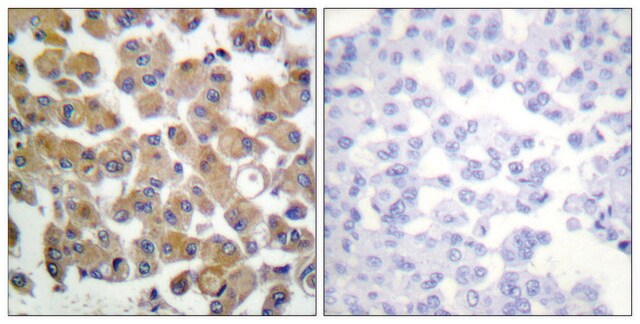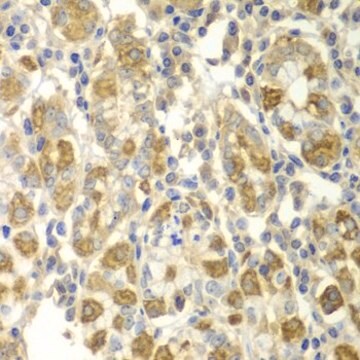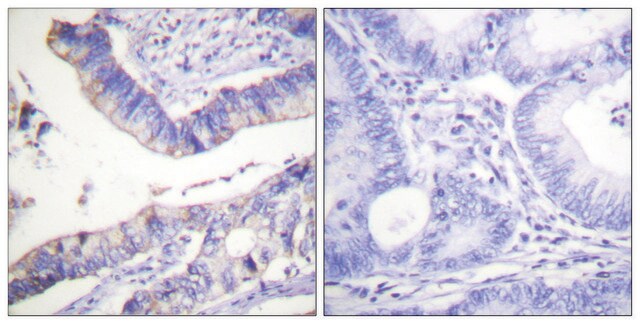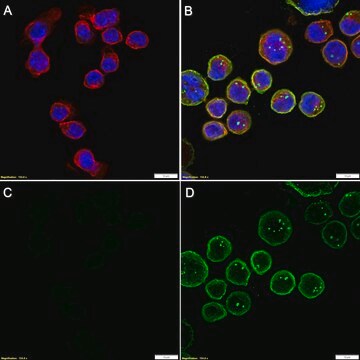추천 제품
생물학적 소스
rabbit
Quality Level
결합
unconjugated
항체 형태
affinity isolated antibody
항체 생산 유형
primary antibodies
클론
polyclonal
양식
buffered aqueous solution
분자량
antigen 48 kDa
종 반응성
human
농도
~1 mg/mL
기술
ELISA: 1:10000
immunofluorescence: 1:100-1:500
immunohistochemistry: 1:50-1:100
western blot: 1:500-1:1000
NCBI 수납 번호
UniProt 수납 번호
배송 상태
wet ice
저장 온도
−20°C
타겟 번역 후 변형
unmodified
유전자 정보
human ... VDR(7421)
일반 설명
Anti-Vitamin D Receptor Antibody detects endogenous levels of total Vitamin D Receptor protein.
Vitamin D receptor (VDR) gene codes for a nuclear receptor. It is expressed at a high level in the hypothalamus and the large neurons of the substantia nigra in the brain. VDR gene comprises 14 exons and 6 untranslated exons with alternative splicing sites. It is mapped to human chromosome 12q13.1.
면역원
The antiserum was produced against synthesized peptide derived from human Vitamin D Receptor.
Immunogen Range: 181-230
Immunogen Range: 181-230
애플리케이션
Anti-Vitamin D Receptor antibody produced in rabbit has been used in western blotting and immunofluorescence staining (1:200) (1:100).
생화학적/생리학적 작용
Vitamin D receptor (VDR) protein modulates genes associated with inflammation, chronic diseases, oxidative damage, and the metabolism of bone. VDR gene is involved in the susceptibility of type 2 diabetes mellitus (T2DM). The nuclear receptor encoded by the VDR gene possesses pluripotent effects. It is capable of specifically binding the elements of DNA response when bound to the ligand. VDR acts as a receptor for 1,25 dihydroxyvitamin D3 (1,25(OH)2 D3). It facilitates the biological activities of vitamin D. Inadequacy of vitamin D is a risk factor for Alzheimer′s disease (AD).
특징 및 장점
Evaluate our antibodies with complete peace of mind. If the antibody does not perform in your application, we will issue a full credit or replacement antibody. Learn more.
물리적 형태
Rabbit IgG in phosphate buffered saline (without Mg2+ and Ca2+), pH 7.4, 150mM NaCl, 0.02% sodium azide and 50% glycerol.
면책조항
Unless otherwise stated in our catalog or other company documentation accompanying the product(s), our products are intended for research use only and are not to be used for any other purpose, which includes but is not limited to, unauthorized commercial uses, in vitro diagnostic uses, ex vivo or in vivo therapeutic uses or any type of consumption or application to humans or animals.
적합한 제품을 찾을 수 없으신가요?
당사의 제품 선택기 도구.을(를) 시도해 보세요.
Storage Class Code
10 - Combustible liquids
WGK
nwg
Flash Point (°F)
Not applicable
Flash Point (°C)
Not applicable
가장 최신 버전 중 하나를 선택하세요:
C Del Puerto et al.
The British journal of dermatology, 179(1), 95-100 (2017-11-07)
Vitamin D deficiency is associated with higher risk of cancer, possibly due to its antiproliferative, antiangiogenic, proapoptotic, cell-differentiating and anti-invasive effects. The anticarcinogenic role of vitamin D in melanoma is still a matter of debate. Loss of nuclear and cytoplasmic
Franz J J Rieder et al.
The Journal of steroid biochemistry and molecular biology, 165(Pt B), 356-362 (2016-08-16)
Vitamin D (VD) is essential for the human body and involved in a wide variety of critical physiological processes including bone, muscle, and cardiovascular health, as well as innate immunity and antimicrobial responses. Here, we elucidated the significance of the
Dao-Jun Chen et al.
Oncotarget, 8(37), 62099-62110 (2017-10-06)
Vitamin D has been recognized as a potent immunomodulator and its deficiency is common in different population groups including patients with SLE. As miRNAs regulation plays a significant role in SLE, the present study aimed to evaluate the association between
Issam Francis et al.
International journal for vitamin and nutrition research. Internationale Zeitschrift fur Vitamin- und Ernahrungsforschung. Journal international de vitaminologie et de nutrition, 91(1-2), 124-132 (2019-10-19)
Vitamin D deficiency is an emerging risk factor for breast cancer suggesting its role in breast cancer pathogenesis. Recent evidence suggests vitamin D receptor (VDR) expression is a prognosis predictor in breast cancer. We set out to determine the status
Seong Min Lee et al.
Endocrinology, 155(11), 4137-4148 (2014-08-26)
The syndrome of hereditary 1,25-dihydroxyvitamin D-resistant rickets (HVDRR) is a genetic disease of altered mineral homeostasis due to mutations in the vitamin D receptor (VDR) gene. It is frequently, but not always, accompanied by the presence of alopecia. Mouse models
Global Trade Item Number
| SKU | GTIN |
|---|---|
| SAB4503071-100UG | 4061837745911 |
자사의 과학자팀은 생명 과학, 재료 과학, 화학 합성, 크로마토그래피, 분석 및 기타 많은 영역을 포함한 모든 과학 분야에 경험이 있습니다..
고객지원팀으로 연락바랍니다.








